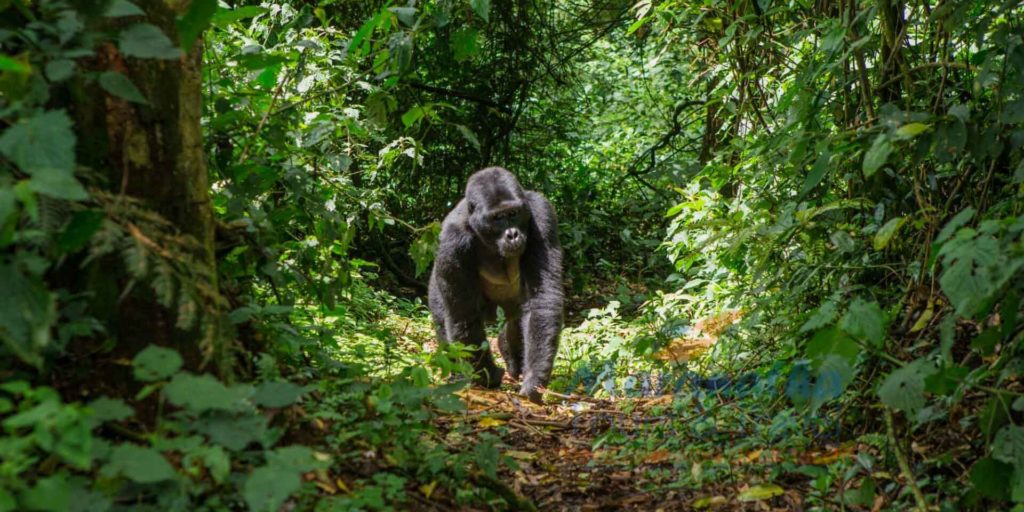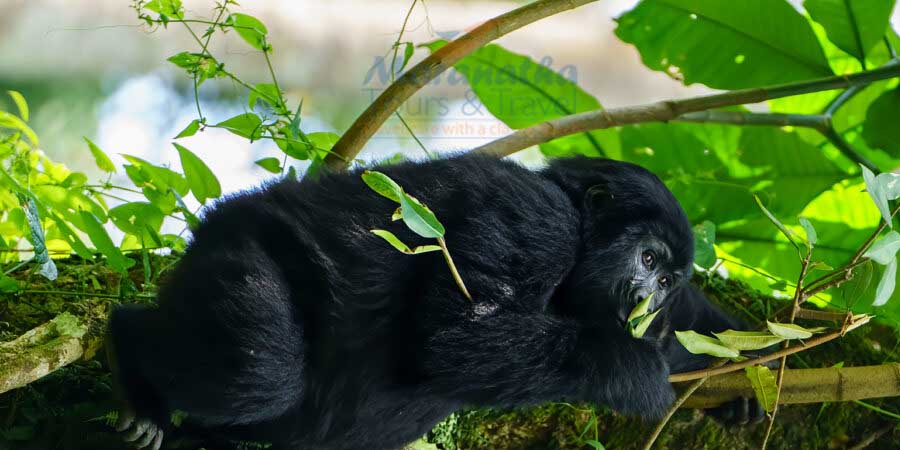Bwindi Impenetrable National Park
At the edge of the Albertine Rift lies Bwindi Impenetrable National Park, notably one of the world’s best Gorilla Trekking destinations. Set in the extreme Southwestern Uganda, Bwindi National Park was established in 1991 primarily to host endangered mountain gorillas which today standout as iconic attractions not in Uganda but the world at large. Because of its ecological biodiversity, Bwindi was later designated among Uganda safari UNESCO World Heritage Sites in 1994.

Bwindi Impenetrable National Park sits on land area measuring up-to 331sq.kms and this is largely composed of a vast impenetrable rainforest. The 331sq.kms park is without doubt a home to one of the ancient “Last Eden” in Africa, protecting one of a few virgin rain-forests on the continent “Bwindi Impenetrable Forest” where it derives its name. The lush Bwindi’s tropical forest is remarkably a home to half of the world’s most sought-after Apes ‘mountain gorillas’ and a range of important bird species. Bwindi Impenetrable Forest dates back to 25000 years making it one of oldest tropical rain-forests in Africa.
Location of Bwindi Impenetrable National Park
Sitting on 331sq.kms of land area, Bwindi Impenetrable National Park is geographically perched on the Albertine Rift Valley edge, Southwestern Uganda just close to border with the D.R. Congo. It is undoubtedly Africa’s biodiversity hot spot lying on altitudinal range of 1160 to 2706m. Its habitats lie at the intersection of the East Africa, Albertine and Congo Basin ecological zones.
Vegetation of Bwindi in Uganda
Bwindi Impenetrable Forest National Park is a home to distinct vegetation zones, each ranging on different altitudes and offer shelter to park’s diverse wildlife species. The park’s altitudinal variations from 1190 to 2607m also come with vegetation variations comprising of bamboo, lowland & montane vegetation zone. The park’s rainforest comprises of 220 tree species, 1000 plants including vines, ferns, shrubs and others. The vast vegetation cover plays a significant role not only as a main habitat to park’s wildlife species but also as main water catchment in the area.
Bwindi Forest is without doubt the main source of water for most of the rivers including River Munyaga, River Ivy and others that drain their water into Lake Edward while River Shogi drains into Lake Mutanda. While on Uganda safari especially hiking/nature walk, you can have a chance to explore some of these scenic rivers in Bwindi Impenetrable National Park.
Wildlife in Bwindi Impenetrable National Park
Bwindi Impenetrable National Park is often visited due to its unique wildlife which aren’t found in other parks. It protects rare forest species of wildlife that include primates like Mountain gorillas, which also share the same habitat with Chimpanzees, L’Hoest monkeys, blue monkeys, Olive baboons, Pottos, Black and white colobus monkeys, Galago, Red tailed monkeys. The other important mammal species Uganda safaris should expect to come across in Bwindi Impenetrable National Park include duikers, forest elephants, giant forest hogs, civet, bush pigs and others.
Birds
A total of about 360 bird species all reside within the jungles of Bwindi Impenetrable National Park (BINP), and they include 24 Albertine endemic species. This makes it a true hot spot for bird watching and while on Uganda safaris or birding tour, expect to unique birds including the Grauer’s broadbill, Blue headed sunbird, Dusky crimson wing, Regal sunbird, Shelley’s greenbul, Rwenzori batis, Dusky twin spot, African wood owl, Chapin’s fly catchers, Strange weavers, Rwenzori doubled collared sun birds, Archer’s robin chat, Yellow eyed black flycatchers, Kivu ground thrush, Chestnut throated apalis, Red faced woodland warblers, Montane masked apalis. Others include among many the Red throated alethe, Stripe breasted tit, Rwenzori turaco, Montane masked apalis, Cassisn’s Hawk eagle, Dwarf honey guide, Montane oriole, grey cuckoo shrike, African emerald cuckoo, Blue tailed flycatchers, Crowned hornbill, Grey headed sparrow, Blue eared starling, Turner’s eremomela, Short tailed warblers, Red headed blue bill.
Tour activities in Bwindi Impenetrable National Park
Gorilla Trekking
Gorilla Trekking is without doubt Bwindi’s safari highlight, offering life changing experiences to Uganda safari tourists. About 20 gorilla families have been habituated by Uganda Wildlife Authority and research authorities making it the most sought for Gorilla Tracking destination in Africa. The 20 groups all reside within the 4 main Bwindi Gorilla Trekking regions including Ruhija, Buhoma, Nkuringo and Rushaga. The 4 regions are all under the management of Uganda Wildlife Authority (UWA).

-Buhoma sector is geographically lying on the Northern Bwindi side. About 4 habituated gorilla families reside with Buhoma Gorilla Trekking area and they include the very oldest group Mubare which opened for gorilla tourism in 1993. Others include Rushegura gorilla family group-underwent habituation from 2000-2002, Habinyaja group family-from 1997 to 1999 when it was officially opened for Gorilla Trekking. Recently, Katwe was opened for Gorilla tourism making Buhoma region a home to 4 habituated families all set for trekking purposes.
-Ruhija sector which is the Eastern Bwindi Gorilla Trekking region is comprised of 4 habituated families though one is set for research purposes. The group of gorillas to track in Ruhija area include Oruzongo, Mukiza, Bitukura and Kyaguriro (set for research but trekked as well).
-Rushaga Area-Lying on the Southern Bwindi, Rushaga without doubt shelters the highest number of habituated group families about 9 of them. They include Nshongi, Bikingi, Kutu, Bweza, Mishaya, Busingye, Rwigi, Mucunguzi, and Kahungye.
-Nkuringo sector; this is another interesting Bwindi Gorilla Trekking area in the south and has 3 gorilla families. These include Christmas, Nkuringo and Bushaho.
Gorilla Trekking rules/safety measures
- Maintain a safe distance of 10m from Mountain gorillas.
- Don’t visit gorillas in Bwindi if you are sick/ill.
- Don’t use flashlight cameras when taking pictures of Bwindi’s gorillas.
- Wear a mask.
- Burry any sort of human waste at least 30cm deep as instructed by your guide.
- You have a guarantee of 1 hour to be with gorillas once you have come across them in Bwindi Forest.
- While in the Bwindi jungles, keep your voices low.
- Stay calm in case a gorilla charges at you-this applies to all gorilla trekkers in Uganda, Rwanda or D.R. Congo.
- Only persons of 15 years and above stand a chance to engage in a trek to see gorillas.
- A valid gorilla permit must be presented before authorities for verification.
Gorilla Trekking Permits
Bwindi’s 20 habituated gorilla families translate into about 160 gorilla permits which Uganda safari tourists can purchase in order to engage in Gorilla Trekking experience. In Uganda, each of the 160 gorilla permits can be booked at USD700 for foreign non-residents, USD600 foreign residents & East Africa citizens UGX250,000. Contact us to book your Bwindi gorilla safari and also reserve a gorilla permit on your behalf without you going through the tedious process.
Gorilla Habituation Experience
Besides the usual Gorilla Trekking safaris, Bwindi is notably the only place worth visiting for Gorilla Habituation Experience. This is by far an extra-ordinary experience involves scientists/researchers/trackers who engage in a long day monitoring or following semi-gorilla family as they make its members get used to humans. It takes a process for UWA to habituated gorilla families before they are opened for gorilla treks and this often takes about 1-2 years. The Gorilla Habituation Experience permits cost Uganda safari travelers USD 1500 and you have 4 hours to be with gorilla family unlike the 1 hour if you undertook the normal gorilla trek.
Birding in Bwindi Impenetrable National Park
Bird watching is undeniably unmissable on-foot walk experience in Bwindi N/Park. There are over 360 bird species residing within Bwindi Impenetrable Forest alone and the important areas to consider a must-visit for bird watching here include Mubwindi, Bamboo zone, Buhoma waterfall trail. The special birds of Bwindi N/Park include African wood owl, Regal sunbird, African broadbill, Red headed blue bill, Handsome Francolins, Kivu ground thrush, Rwenzori batis.
Mountain biking/Cycling
The one exciting experience Uganda safari travelers shouldn’t leave without enjoying is cycling. Mountain biking is an exceptional experience often organized by Ride 4 a Woman; a community initiative aimed at supporting the locals. They even have bikes to be hired by participants on cycling tour and the activity is always done along Buhoma area in the Northern part of Bwindi N/Park.
Batwa Encounter
Bwindi has endless options to explore and experience it, with addition of Batwa cultural experience, you won’t regret in life. This mainly introduces you into the Batwa pygmy community to have a memorable interaction with the Batwa.
The other exceptional activities Bwindi has to offer include guided nature or forest walks along the many trails, Buhoma village walk.
Best time to travel to Bwindi – Uganda safari park
Bwindi National Park welcomes all visitors on safari in Uganda all-year-round but, the dry season is the best in case you are interested in tracking to see mountain gorillas. The dry season is divided into 2; the first that begins from June to September and December to February.
The popular accommodations in Bwindi Impenetrable National Park (BINP)
There are countless accommodations to book for your stay while on Bwindi safari and they range from budget to luxury-all distributed across the 4 of the regions. But, the most popular ones include;
-Budget lodges; – Buhoma Community Bandas/Nshongi Camp/Ruhija Community Rest Camp/Bwindi Backpackers Lodge/Gorilla Friends Resort, Bwindi Backpackers Lodge.
-Mid-range/Moderate; –Ichumbi Gorilla Lodge/Bakiga Lodge/Gorilla Forest Camp/Gorilla Valley Lodge/Haven Lodge.
-Luxury; -Mahogany Springs Lodge/Buhoma Lodge/Ruhija Gorilla Safari Lodge/Volcanoes Safaris Bwindi Lodge/Chameleon Hill Lodge/Gorilla Mist Camp.
Getting to Bwindi National Park – by Road/air
By road; From Kampala/Entebbe, Bwindi N/Park (BINP) is 8-9 hours’ drive and in case someone connects from Queen Elizabeth National Park, it is just 3-4 hours’ drive. From Kigali, access to Bwindi is available via Katuna or Chanika border about 3-4 hours’ drive.
The quickest alternative is flight from Entebbe Airport to Kisoro airstrip if you plan to visit Rushaga/Nkuringo regions of Bwindi in the south then the Northern and Eastern sectors, Kihihi airfield is the closest place to land in. From the airstrip, your driver guide can then connect you to the lodge at Bwindi National Park.
